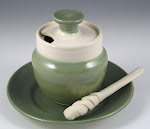Mingei is the Japanese concept-word for art made by hand by ordinary people. As a formal movement, Mingei is only about 50 years old. But it is retroactive. It gives a name to works both ancient and recent, work that fits into this idea.
If you go to the Mingei International Museum in San Diego, you will find art made by hand and art not made by hand, a few pieces by people whose names were never recorded and more by people who are known. It is all supposed to be Mingei.
When I learned about Mingei, as a ceramics student in college, I learned that earlier Mingei potters tended not to sign their work. They regarded themselves and their pottery as part of the art of life, above ego. Their pots were their signatures. Ego eventually wins out most of the time, though, and contemporary potters usually sign their work. I do.
At the museum (all photos are from the museum's beautiful website): Jean Balmer’s garden forms.
Forms? These are like big hollow pebbles with holes in the top. Could in theory catch a little rain for a critter with a long thin nose or beak to drink from. Could certainly catch your eyes and take them around and around the shapes. Real function? Visual interest. Environment enhancement. Could a “regular” potter make these? Yes.
Jack Rogers Hopkins’s Mirror Chairs
I wanted to sit in these. They were so curvaceous and sinuous. Function? Certainly. Unusual, but functional. Form? Wowee. Could a regular chair maker make something like these? If one dreamed of this form, or copied Hopkins’s, one could.
Tim Crowder’s Chair:
A rocker made of leather and wood, this had a medieval sort of feeling. Unusual? Yes. Functional? Yes. Repeatable if someone took it into his head to do so? Yes.
Being in a museum, these were not touchable, only viewable. But. Want. To. Touch. (If I may point out the obvious, potters are into the tactile.) And in my own way, that is my definition of Mingei: Can Be Touched. Yes, if we are to see examples of beautiful, usually functional objects made by hand by art-inclined ordinary folks, we have to save some of these things in a collection and metaphorically rope them off. But this roping off always makes me feel subversively inclined. However, law abidement prevailing, I did not touch. Instead, I made a note and decided to sort of touch them with my thoughts later.
A smaller part of the museum is devoted to mass-produced wares, also designed to function well and be attractive or interesting at the same time. I won't agree that machine made objects can be as imbued with individuality as handmade; it is antithetical. But I guess they can be Mingei if you stretch the term a little to mean well designed objects that function artfully. There's where "Mingei" becomes a bit too fuzzy an idea.
But still. Taking "Mingei" to mean art for the people by the people that's also reproducible, machine reproduction has to be figured into the idea. In the gift shop, a set of cast teabowls caught my eye. Four smallish, handleless cups, each glazed in a different color for variety, these were packaged in an elongated rectangular box with a perfectly sized section for each teabowl. The box was part of the presentation. Against my aesthetic will (call it kickwheel potter's snobbery), I found these manufactured cups very appealing, and the whole package satisfying arranged. In Japan, master potters traditionally sold (and still sell) their best pots packaged in individual, handmade wooden boxes, made to order for each size and shape. Mass manufacturers still consider the box as part of the presentation of an object.
Plenty for a potter to think about, after a subversive "touching trip" through the museum in my head.
Subscribe to:
Post Comments (Atom)




No comments:
Post a Comment